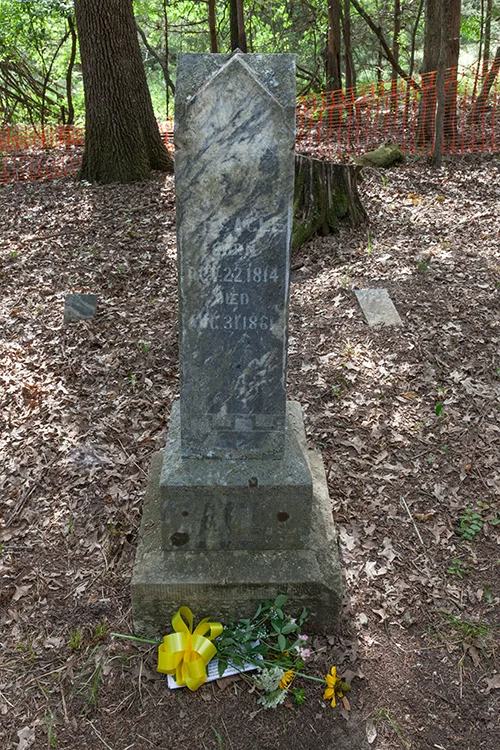Today’s post continues the story of the decoration of the graves with the letters written to the Cagle children. (If you haven’t read the previous post, Ginger and I conducted a ritual in early June of decorating each grave with a wildflower bouquet and a letter expressing what we might say to the recipient if we could.)
Marked only by foot stones with initials, there is some guesswork involved in addressing these letters to the Cagle children. Piecing together what is known from various records about the Cagle family with the initials, we are reasonably confident in the identifications, with a couple of caveats. There are two stones that begin with the initial ‘M”. Which is Martha, which Martin? We have assumed that MSC, lying next to Martin Sr, is Martha. Martha and her father were the first family members laid to rest in the Cemetery and died within a span of two years. It seems an acceptable guess that they might lie next to one another. The second caveat is that the SHH letter is pure speculation - we have no data at all on this burial other than that it is included in the Cagle family row, and has a foot stone identical to the Cagle stones. The assumption that SHH died as an infant or small child is based on the absence of any corresponding adult from the records of the family.
In any case, the sentiments expressed are genuinely placed even if the details might be questioned.
Martha (MSC),
Sweet child, carried off by scarlet fever. Did your little sister, Mary, avoid the illness or did she simply survive it? Did it rage through the entire family, striking your brothers as well? I can imagine the care your mother took of you, the prayers she offered for your deliverance, the anguish she felt as she watched the life ebb from you, and the sorrow with which she laid you to rest. With the possible exception of the unknown grave, you are first inhabitant of the Cemetery. I wonder how the location was chosen. Was it simply convenient, was it special to you, or special to your mother? Did you once play where you now lie? I will, in any case, think of you at play in the fields of the Lord.
Martin (MVC),
Martin, a strapping boy carried off at the age of 15 or 16. Your loss must have been a great blow to your mother and siblings. Another sad addition to the Cemetery, the graves now beginning to form a row. I wonder how close the Cemetery was to the house the family lived in. No trace of that house exists today, and no knowledge of where it might have been. I wonder If your mother was able to walk out in the cool of the early evening and visit with you, your sister, and your father. Perhaps she sat by your grave and spoke to you, finding solace here among her dead.
Edward (ECC),
A young man cut down in your prime, perhaps a casualty of the Civil War, perhaps dying here in Fannin County before the call of war caught up with you, you lie here in obscurity. Though as I think about it, it is only obscurity for those of us who walk the Cemetery today. You were undoubtedly laid to rest lovingly in the bosom of your family. Though your rest is soon to be disturbed, you will remain surrounded by those who knew and loved you.
John (JHC),
You last appear in the historical records as a young boy of 9 in the 1860 census. The date of your death we cannot know. Did your sister, Frances, take responsibility for you and Mary after your mother died and your brothers were called to war? Did you live to become a young man or did you succumb to a childhood illness? We must rest content that whatever your earthly history, you now reside with your family in a realm beyond our ken.
SHH,
You are a mystery. Your position in the Cemetery indicates that you are member of the Cagle family. That much seems very clear. I believe you to be an infant or child of Frances Cagle. Frances married Thomas Hale in 1856, and I am guessing your identity based on the initial of your last name. Though I can find references in the genealogical record of your parents and several of their children, none of the initials match yours exactly. Perhaps you died as an infant and disappeared from any official records. Rest in peace, Little Lamb.
Wilks Cemetery - Making of the Wildflower Bouquets, photo by Ginger Sisco Cook.
Wilks Cemetery - Cagle Foot Stone Letters and Bouquets, photo by Ginger Sisco Cook.
Story by Wanda Holmes Oliver.







